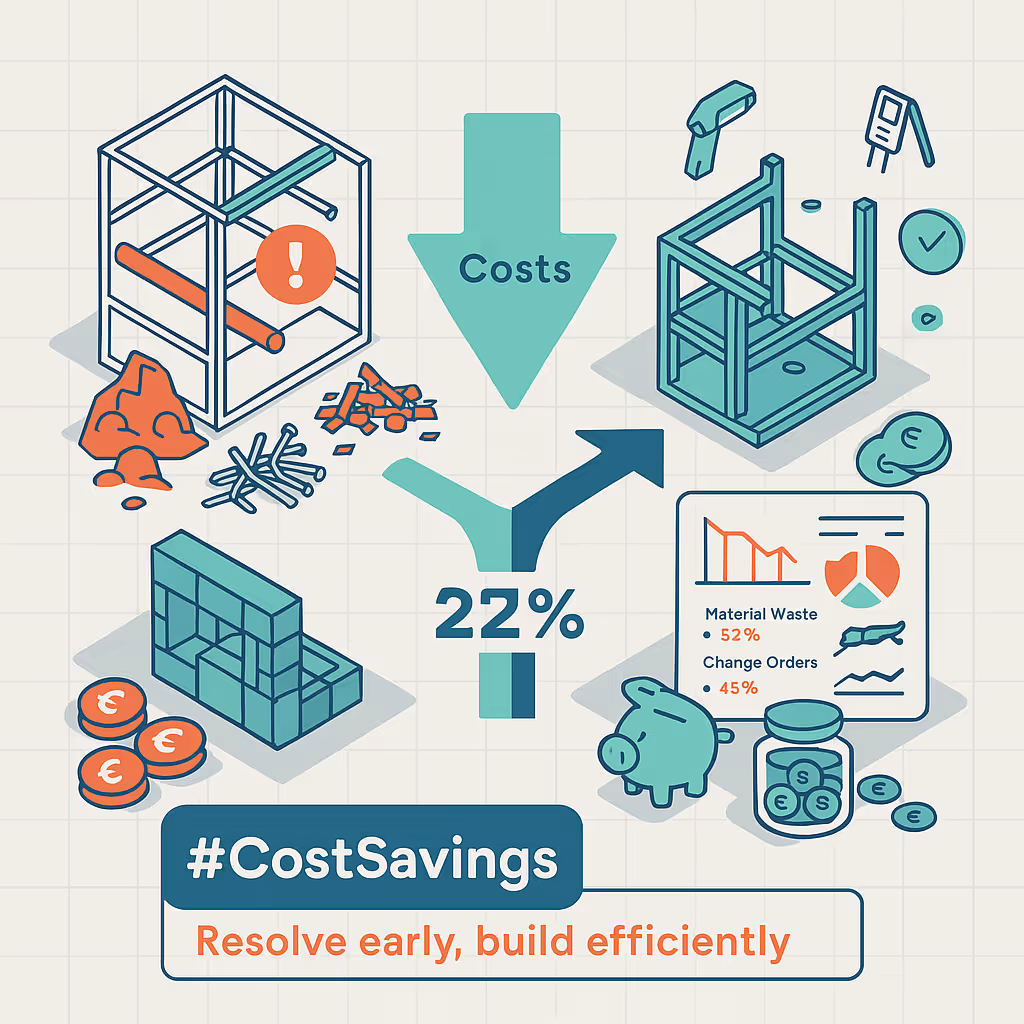Early Conflict Identification
Find and resolve issues during design when they're easiest and least expensive to fix.
The traditional approach to building design and construction often defers conflict resolution to the construction phase—when problems are most expensive and disruptive to address. Our clash detection services shift this paradigm by identifying conflicts early in the design process, when resolution is simpler and more cost-effective.
By detecting clashes during design development, we help you avoid costly changes, delays, and disputes during construction—delivering significant value to your project's bottom line and timeline.

The Cost of Late Detection
The financial impact of finding conflicts late in the project lifecycle is well-documented:
- Exponential Cost Growth - A clash that costs €100 to fix in design can cost €1,000 during pre-construction, €10,000 during construction, and €100,000 or more after construction.
- Schedule Disruption - Late-discovered clashes often require work stoppages, redesign, reordering of materials, and rescheduling of trades.
- Cascading Problems - One unresolved clash often creates a chain reaction of issues that affects multiple systems and disciplines.
- Relationship Strain - Late conflicts frequently lead to disputes between owners, designers, and contractors about responsibility and costs.
- Quality Compromises - Under pressure to maintain schedules, teams often implement sub-optimal solutions to field conflicts.
When to Start Clash Detection
Schematic Design (SD)
Value: High
Though models lack detail, early clash detection can identify major system conflicts and space allocation issues that would be costly to address later.
Design Development (DD)
Value: Highest
Optimal phase to begin comprehensive clash detection. Models have sufficient detail to identify most significant issues, yet design remains flexible enough for efficient resolution.
Construction Documents (CD)
Value: Medium
Late but still valuable. Resolving clashes at this stage requires more documentation revisions, but still prevents costly field issues.
Pre-Construction
Value: Low-Medium
Better than nothing. Identifying clashes before breaking ground can still prevent some field issues, but requires design revisions and potential delays.
Our Early Detection Approach
Coordination Strategy
We establish clash detection protocols early in the design process, including clash matrices, tolerance settings, and coordination schedules.
Progressive Model Review
We implement regular clash detection cycles as models develop, focusing on appropriate issues for each design stage.
Cross-Disciplinary Workshops
We facilitate collaborative workshops where design teams can resolve conflicts together and incorporate solutions into their developing models.
Systematic Issue Management
We document all identified conflicts, track resolution progress, and maintain accountability throughout the design process.
Pre-Construction Validation
We perform final clash detection before construction to verify that all identified issues have been resolved appropriately.
Early Detection in Action

Healthcare Facility Success Story
For a 35,000 m² healthcare facility project, we implemented clash detection starting in the early design development phase, focusing on critical systems coordination.
The results demonstrated the value of early conflict identification:
- 837 significant clashes identified during design development
- 98% of clashes resolved before construction document completion
- 75% reduction in mechanical and electrical RFIs during construction compared to similar previous projects
- €560,000 in direct cost savings from avoided change orders
- Project completed 5 weeks ahead of original schedule due to reduced on-site coordination issues
The project manager noted: "Early clash detection was one of our most valuable investments. What might have been major headaches in the field became simple coordination exercises during design."
Common Early-Stage Conflicts
Our early detection process focuses on these high-impact conflict types:
Structural/MEP Conflicts
Beams intersecting with ductwork, piping through structural elements, and other major system interferences that require significant redesign if found late.
Ceiling Plenum Congestion
Insufficient space for all required systems within ceiling cavities, a common issue that can lead to on-site improvisation and compromised system performance.
Access and Clearance Issues
Insufficient space for equipment maintenance, code-required clearances, and accessibility requirements that could create compliance issues.
Vertical Shaft Alignments
Misalignments in multi-story risers, shafts, and chases that can cause significant rework if discovered during construction.

Related Services
Don't Wait for Problems to Become Expensive
Start clash detection early in your project to prevent conflicts from reaching the construction site. Contact us to discuss how our early conflict identification services can save your project time and money.
